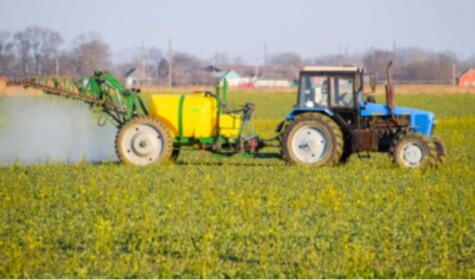Defra has just launched a package of measures to help farmers facing huge increases in the price of fertiliser.
The cost of nitrogen fertiliser is currently three times higher than it was last year. This makes it an appropriate moment to consider the dependence of intensive agriculture on synthetic nitrogen and whether the prospect of green hydrogen to make fertiliser with a lower environmental footprint offers a long term solution.
A brief history of nitrogen fertiliser
Since the Second World War, synthetic fertilisers, especially those made from ammonia, have played a major role in agriculture on almost all farms except those using organic methods. These have driven a dramatic increase in production through higher yields, but that has come at a high environmental cost in terms of greenhouse gas emissions, air pollution from ammonia, water pollution from high levels of nitrate and biodiversity decline in terms of delicate wild flowers and plants outcompeted by ranker vegetation better able to ulitise nitrogen.
Today, the UK uses just over one million tonnes of nitrogen every year, in over three million tonnes of nitrogen fertiliser, with different products containing different proportions of nitrogen. Ammonia is produced by the Haber-Bosch process – named after German scientists Fritz Haber and Carl Bosch who developed a method to produce synthetic ammonia in 1911. This process turns the inert nitrogen in the air we breathe into reactive nitrogen, by breaking the triple bond which holds nitrogen atoms together in pairs, then forcing them to combine with hydrogen. This requires a temperature of 500°C, 250 atmospheres of pressure (approximately 120 times the pressure in a typical car tyre) and an iron catalyst.
The initial motivation was the prospect of war with Britain. Ammonia is essential for the production of explosives and had Haber and Bosch not made their breakthrough, the huge scale of the carnage during the First and Second World Wars would not have been possible.
At the end of both wars, the world was left with massive industrial capacity to produce ammonia for which there was suddenly no demand. However, in the 1940s it was realised that this ammonia could also be used to create nitrogen fertilisers, with the Rockefeller Foundation in the US pioneering their development for use in Mexican agriculture. While the programme was not well suited to Mexico, the experience gained underpinned the promotion of synthetic nitrogen fertilisers in developed countries from about 1950.
Haber and Bosch originally produced the hydrogen they needed to make amononia by passing an electrical current through water. However, producing hydrogen through electrolosis in this way is extremely energy intensive and it was later found that by using natural gas as the source of hydrogen the amount of energy needed could be reduced considerably. Even today, however, the process of making ammonia still requires a lot of energy. It accounts for 1.4% of global carbon dioxide equivalent emissions (much of this in the form of nitrous oxide and CO2) and consumes 1% of the world’s total energy production. Hydrogen (and the ammonia produced with it) is currently made using either Steam Methane Reforming or Auto Thermal Reforming with natural gas. This is known as grey hydrogen (or blue hydrogen, when the associated CO2 emissions are captured and stored underground). Given the significant contribution to the climate crisis, finding an alternative, less carbon intensive method of creating ammonia has long been desirable. This is where green hydrogen comes in.
Green hydrogen
The concept of ‘green hydrogen’ is now being promoted as a new climate friendly way to create and store energy to reduce our dependency on fossil fuels, with the potential to make greener nitrogen fertilisers as well. Green hydrogen production relies on the original Haber-Bosch method of splitting water by electrolysis (using electricity from renewable energy sources), which results in only two outputs: hydrogen and oxygen, neither of which directly contributes to global warming or air pollution. The hydrogen can be stored safely under pressure in fuel cells and the oxygen can be vented to the atmosphere with no negative impact. There are many uses for green hydrogen, including a potentially important role within agriculture as a replacement for the fuel used by tractors and other heavy machinery. However, of greater interest to many is that green hydrogen fed into the traditional Haber-Bosch process can be used for ammonia production which is then used to make fertilisers like ammonium nitrate.
Since this green ammonia is 100% renewable and largely carbon-free switching to green ammonia would greatly reduce the carbon footprint of nitrogen fertiliser production. This is a good thing. In theory, it would help us get closer to net carbon zero. Any steps we can take to reduce our global carbon footprint are clearly essential to the efforts to limit global warming to below 1.5 degrees by 2050 and 2 degrees by the end of the century, avoiding the worst predicted aspects of climate change. As such, it makes sense to support a switch to green ammonia from both grey and blue ammonia production. Price, however is still a limiting factor. The cost of green hydrogen is currently still high, but given the impact of the Ukrainian conflict on energy prices and the finite nature of natural gas reserves, the option to produce ammonia from green hydrogen is appealing since it is expected that at some point over the next 5-10 years, it will become lower in price and possibly also less susceptible to price fluctuations than when grey (or blue) hydrogen is manufactured and used. This could eventually help farmers, already under financial pressure and worried about rising input costs – a challenge that Defra is partly addressing though a package of measures unvailed recently.
But might green hydrogen be a false prophet?
One big advantage of green hydrogen is that it provides a way to store energy from wind turbines and solar panels to use overnight and on days when the wind isn’t blowing and the sun isn’t shining. But one of the biggest questions is whether it will be possible to produce enough renewable electricity in the UK to make sufficient green hydrogen for all our needs? As already mentioned, using electricity to make hydrogen for fertiliser production instead of natural gas is significantly more energy intensive overall. There is a great deal less pollution, but much more energy is needed in total. Given the need to use hydrogen to replace diesel and the dramatic increase in renewable energy we will need to achieve net zero carbon emissions by 2050, the scale of the problem is huge. There has to be a further question over whether we have enough land in the UK for sufficient solar panels and windmills, without taking excessive areas of land out of food production? As such, it seems likely that we will remain dependent on other countries for much of our energy needs, even once green hydrogen becomes a financially viable option. The obvious place to produce energy from solar power is in deserts, but the hydrogen would need to be made close to vast sources of water as, according to our initial calculations, it will require approximately six litres of water to make enough hydrogen to replace one litre of diesel.
Seeking an altogether greener approach
The current model of industrial agriculture relies on artificial inputs to maintain high yields and productivity. This has been achieved to the detriment of the environment and human health. Agriculture is the source of over 80% of ammonia emissions in the UK and ammonia is a major cause of air pollution. Even if it is possible to produce a ‘greener’ form of synthetic fertiliser at scale, green ammonia-based synthetic fertilisers will still cause some of the same environmental problems associated with current nitrogen fertiliser use, including fertiliser run-off into streams, which creates dead-zones in rivers, lakes and even some oceans through eutrophication. Producing enough hydrogen to make the 190 million tonnes of fertiliser nitrogen used globally each year could also put additional strain on the planet’s already inadequate supplies of fresh water in many regions.
Recognising the damage caused by synthetic fertiliser, the SFT and others in the sustainable farming sector have long been advocating a switch toward more agroecological farming systems. We believe that we need bold change if we want to create a more sustainable food and farming system. A switch to agroecology would be that change. Agroecology employs natural methods of nutrient cycling to build soil health. For example, using forage legumes in grassland, in rotation with crops and as cover crops, which bring natural nitrogen into the soil. The benefits of adopting such methods is that this allows farming to function in harmony with nature and available natural resources, it also aims to reduce negative externalities while still ensuring a productive and viable farming sector.
Of course, it is unrealistic to think that the world will ditch its dependency on nitrogen fertilisers overnight, and so where these continue to be used green hydrogen is likely to have a valuable role in reducing the emissions associated with their manufacture. Yet, green hydrogen should not be viewed as the primary solution to the nitrogen fertiliser ‘problem’. Ultimately, as opposed to challenging that long-entrenched dynamic of high-input industrialised agriculture, switching to green hydrogen could merely maintain the status quo of ammonia-dependent and polluting farming systems. Despite lowering the carbon footprint, it may create additional problems while enabling food to be produced with the same high levels of synthetic fertiliser, without introducing more fundamentally sustainability components into production methods.
Conclusion
As a result, adopting an approach that sees green ammonia as a solution to creating a more sustainable farming system might be misguided. It could help a little but it is not a panecea. Rather than moving towards the systemic change and a shift to agroecological practices that is needed, this could undercut delay the urgent need to transition in the direction of agroecology. We need to continue to push for bolder change, ultimately ensuring we stay within all planetary boundaries, allowing us and future generations to maintain a healthy and habitable planet.




